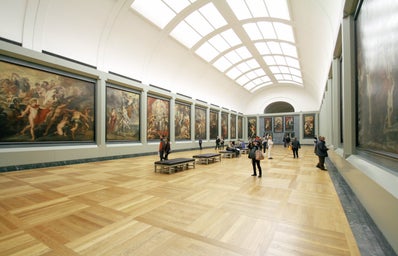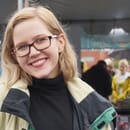The National Museum of Women in the Arts created a space for internationality in the abstract art world with their latest exhibit, Magnetic Fields: Expanding American Abstraction.
The big names in abstractionism are mostly white men. Jackson Pollock. Mark Rothko. Piet Mondrian. The curators of Magnetic Fields noticed that and thought: Where are the women and people of color? Were they doing this? And do they deserve the same recognition?
The answer is yes, and their reasoning lies through out this exhibit. The intergenerational display of black, female, and abstract artists aims to prove that we should know these women while providing a space for all types of abstraction.
But the curators clarified that this is just one conversation. There are more layers of abstraction and more artists who deserve attention, however, Magnetic Fields is still a well-rounded dive into the discussion.
On top of that, not every piece is a conversation about identity. Too often, curators force the themes of identity politics onto minority artists. While some artwork revolves around discussion of identity, sometimes the piece is just about a place or a particular experience. That’s why these curators did everything in their power to understand the artist’s intent of each composition.
The name for the exhibit comes from this piece (titled, of course, Magnetic Fields) by Mildred Thompson. The curators said they’re inspired by the way the pieces push and pull between each other to create the full experience of the exhibit. This work is meant to be Thompson’s interpretation of actual magnetic field.
Mildred Thompson, Magnetic Fields, 1991; Oil on canvas, triptych, 70 1/2 x 150 in.; Courtesy of the Mildred Thompson Estate, Atlanta, Georgia; Art and photo © The Mildred Thompson Estate, Atlanta, Georgia
A lot of abstract art is meant to convey the artist’s recollection of an experience or place without necessarily being an exact rendition. This theme is especially prevalent through out this show. For example, Harlem Flag by Abigail DeVille captures Harlem at a moment in time. The artist gathered objects from around the neighborhood to tell a story about what Harlem was like in that moment.
Abigail DeVille, Harlem Flag, 2014; Sheetrock, door, American flag, wax, encaustic paint, charcoal dust, wallpaper scrap, window shade, and staples, 96 x 120 in.; Courtesy of the artist, Bronx, New York; © Abigail DeVille; Photo by author.
Black cherry pit by Candida Alvarez, on the other hand, is a mash-up of the artist’s memories and feelings over time. Much of her inspiration comes from her own apartment in New York and her parent’s home in Puerto Rico.
Candida Alvarez, black cherry pit, 2009; Acrylic on canvas, 84 x 72 in.; Courtesy of the artist, Chicago, Illinois; © Candida Alvarez; Photo by author.
This Shinique Smith sculpture, Bale Variant No. 0017, sends a message about excess consumption in America.
Shinique Smith, Bale Variant No. 0017, 2009; Fabric, ink, twine, ribbon, and wood, 72 x 52 x 52 in.; Denver Art Museum Collection; Gift of Baryn Futa to the Collection of the Denver Art Museum, 2013.6A-B; © Shinique Smith; Photo © Denver Art Museum
In the aftermath of Hurricane Katrina, Maren Hassinger created Wrenching News. The twisting and lay out of actual New York Times newspapers invite conversation about social, economic, and political issues.
Maren Hassinger, Wrenching News, 2008; Shredded, twisted, and wrapped New York Times newspapers, 12 x 72 x 72 in.; Courtesy of the artist, New York, New York; © Maren Hassinger; Photo by author
One piece that does touch on identity is Racism is Like Rain, Either it’s Raining or it’s Gathering Somewhere by Mary Lovelace O’Neal. Identity politics are present in the title, but the dark background is reminiscent of the lasting presence of racism in America.
Mary Lovelace O’Neal, Racism is Like Rain, Either it’s Raining or it’s Gathering Somewhere, 1993; Acrylic and mixed media on canvas, 86 x 138 in.; Mott-Warsh Collection, Flint, Michigan; © Mary Lovelace O’Neal; Photo courtesy of the Mott-Warsh Collection, Flint, Michigan
Overall, this show includes a diverse range of stories from many different artists. The pieces I’ve talked about are just a small selection of voices represented at the National Museum of Women in the Arts. For the full experience, go see the show for yourself before it ends on January 21st.
Cover and photos 1 and 2 belong to the author. Other photo credits listed below each image.



